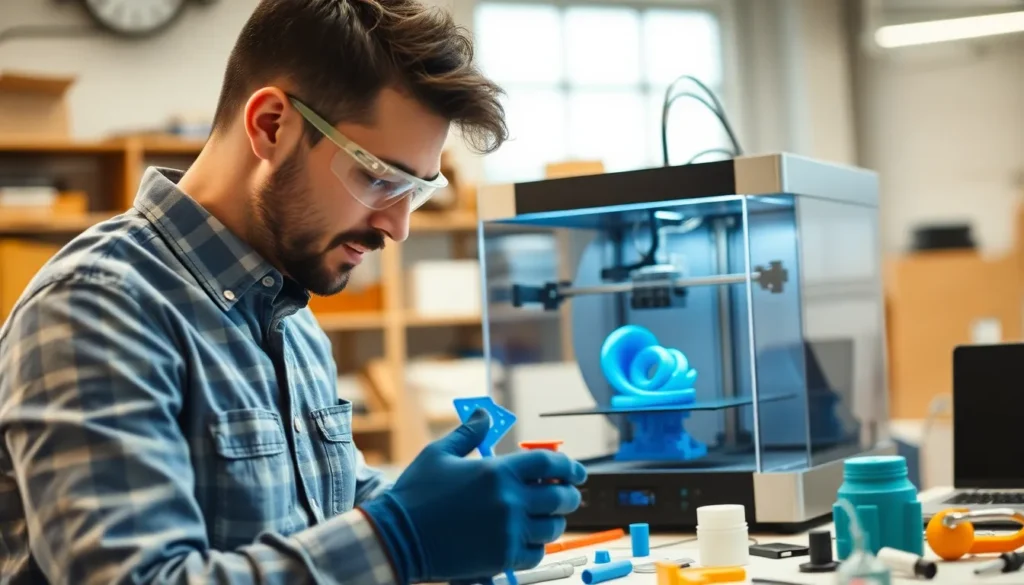Table of Contents
ToggleIn the world of 3D printing, high-detail resin prints are like the overachievers in a class full of average students. They stand out with their stunning precision and intricate details that leave traditional prints in the dust. Imagine a miniature masterpiece that captures every curve and contour, making your friends question if you’ve suddenly become a sculpture prodigy.
But it’s not just about looks; these prints can transform your creative projects from “meh” to “wow” faster than you can say “layering technology.” Whether you’re crafting custom figurines or prototypes that demand attention, high-detail resin printing is your secret weapon. Dive into the realm of resin and discover how it can elevate your creations to a whole new level, all while keeping your sense of humor intact. After all, who said serious art can’t be fun?
Overview of High-Detail Resin Prints
High-detail resin prints represent a significant advancement in 3D printing technology. These prints offer unmatched precision, capturing intricate details that traditional methods struggle to replicate. A noteworthy characteristic of high-detail resin prints is their ability to produce smooth finishes and fine features, making them ideal for applications in art, jewelry, and engineering prototypes.
Precision plays a crucial role in the effectiveness of high-detail resin printing. As a result, it’s possible to create complex geometries and delicate structures with remarkable accuracy. Users benefit from the low_layer_height settings that enhance detail, allowing tiny features to come to life. The output can reach detail levels of up to 50 microns or finer, depending on the resin and printer used.
Materials used in high-detail resin printing vary widely. Standard photopolymer resins, flexible resins, and even specialty resins are available to cater to diverse project requirements. Each type of resin enhances specific qualities, such as flexibility or durability, making it easier to achieve desirable attributes in the final print.
Adoption of high-detail resin printing continues to grow in various fields. Designers leverage these prints for creating custom figurines, miniatures, and prototypes that capture audiences’ attention. Innovation in the technology continuously improves print speed while maintaining high fidelity, making it accessible for hobbyists and professionals alike.
Investments in high-detail resin technology yield benefits beyond mere aesthetics. Applications in sectors like medicine, automotive, and aerospace reveal its potential to revolutionize parts production and rapid prototyping. The increasing affordability of resin printers encourages widespread use, demonstrating how high-detail resin prints enhance creativity and functionality in various domains.
Benefits of High-Detail Resin Prints
High-detail resin prints offer remarkable advantages in various 3D printing applications. Users benefit from exceptional precision and intricate details, elevating their projects significantly.
Superior Resolution
High-detail resin printing achieves remarkable resolution, reaching levels of up to 50 microns. This precision allows for the reproduction of delicate features in models, which traditional methods often struggle to replicate. Fine layers enable a smooth finish, enhancing the overall aesthetic appeal. The ability to create sharper images leads to a more realistic representation of the intended design. Many designers in fields such as engineering and art utilize this quality to refine their creations.
Enhanced Detail
Enhanced detail defines high-detail resin prints, setting them apart from other techniques. Intricate patterns, fine textures and unique shapes emerge clearly without visible artifacts. Such details contribute significantly to the customization of figurines, prototypes and intricate designs. The varyng materials available, including specialty resins, optimize the output for different applications. Artists and manufacturers alike can achieve their vision accurately without sacrificing quality, bringing complex ideas to life seamlessly.
Common Applications
High-detail resin printing finds applications across various fields due to its precision and versatility. These prints greatly enhance the quality of numerous creative projects.
Miniatures and Models
Miniatures and models benefit from the intricate detail that high-detail resin printing provides. Artists create lifelike figurines, enhancing tabletop gaming and hobbyist pursuits. Detail levels up to 50 microns ensure accurate representations of characters or objects. Many designers choose resin printing for architectural models, as these prints capture fine features and complex geometries effortlessly. The results showcase impressive aesthetics and realism, capturing the attention of viewers.
Prototyping
Prototyping utilizes high-detail resin printing for rapid production processes. Engineers and designers rely on precision to test concepts before full-scale production. Features such as intricate designs and functional components emerge clearly through resin prints. Using this method allows for quick iterations and adjustments, saving time and resources effectively. Many industries, including automotive and aerospace, benefit from enhanced physical prototypes. This approach accelerates product development while adhering to strict quality standards.
Material Considerations
High-detail resin prints require careful attention to material choices and curing methods for optimal results.
Types of Resin
Standard photopolymer resin serves as the foundation for many high-detail prints, known for its ease of use and accessibility. Flexible resin delivers durability and bending capabilities, making it suitable for models that undergo stress. Specialty resins cater to specific applications, offering unique properties like high-temperature resistance or biocompatibility. Choosing the right resin significantly impacts print quality and functional attributes. Artists and designers often select resins based on their project needs, combining various types to achieve desired characteristics.
Curing Process
The curing process influences the final quality of high-detail resin prints. UV light exposure activates photopolymer resins, transforming them from liquid to solid. Curing occurs in layers, with each layer needing adequate exposure time to ensure proper hardening. Many printers feature automated curing systems, optimizing exposure to enhance efficiency. Post-curing treatments can further improve the print’s strength and surface finish. Understanding the curing process is essential for achieving precise detailing and structural integrity in printed objects.
Comparison with Other Printing Methods
High-detail resin printing offers distinct advantages over other 3D printing methods. The precision achieved with resin printing sets it apart, making it a preferred choice for intricate designs.
FDM vs. Resin Printing
Fused Deposition Modeling (FDM) uses thermoplastic filaments, while resin printing employs light-sensitive liquids. The difference in materials contributes to varying print quality. FDM produces parts with a layer thickness of 100-300 microns, which often results in visible layer lines. Conversely, resin prints can reach detail levels of 50 microns or finer, offering smoother finishes and sharper features. High-detail projects benefit more from the finer detail achievable with resin, especially in applications like miniatures or dental molds.
Advantages and Disadvantages
High-detail resin printing boasts exceptional resolution and surface quality, making it ideal for complex geometries. Its ability to produce intricate details enhances designs in art, jewelry, and engineering. However, this method also has limitations. Resin prints can be more brittle than FDM prints, impacting durability in functional applications. Additionally, post-processing steps such as curing can be time-consuming. Despite these disadvantages, the aesthetic and precision advantages often outweigh the drawbacks for many users.
Conclusion
High-detail resin printing stands at the forefront of 3D printing technology. Its unmatched precision and ability to produce intricate details make it an invaluable asset for artists designers and engineers alike. As accessibility increases and costs decrease more individuals and industries are likely to embrace this innovative approach.
The versatility of high-detail resin prints opens doors to creative possibilities across various fields from custom figurines to rapid prototyping. While challenges like brittleness and post-processing exist the benefits often outweigh these drawbacks.
Embracing high-detail resin printing can elevate projects transforming visions into reality with remarkable clarity and finesse.




